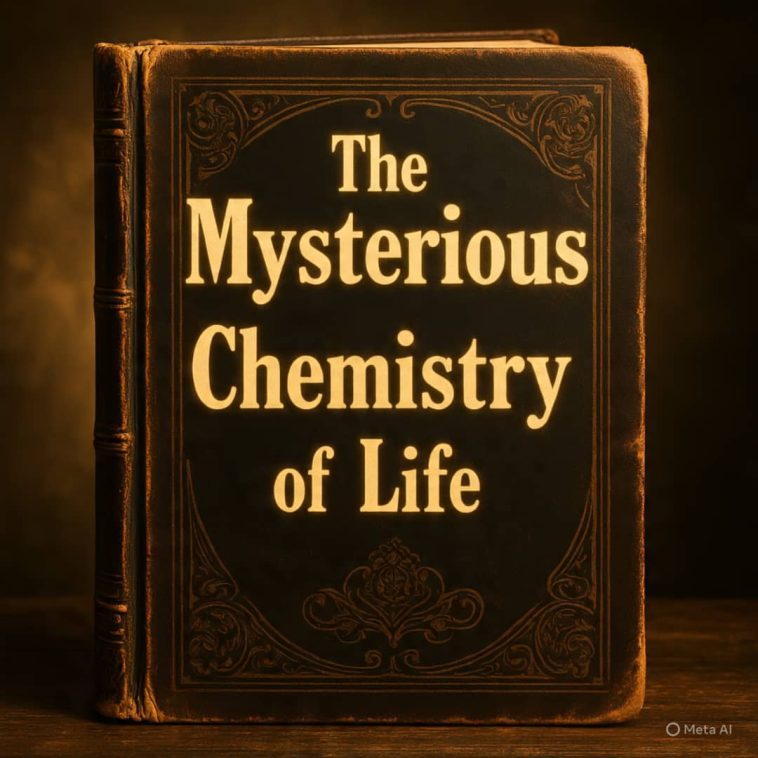Part II: The Molecular Maze
Into the Maze
The spinning slowed, and gradually the molecular currents around us stilled. We floated in a vast, labyrinthine expanse of glowing structures: massive protein complexes, twisting sugar chains, and networks of RNA strands stretching like bridges across the cytoplasmic landscape. The light shimmered softly, pulsing as if the environment itself were breathing.
Patrice gestured ahead. “Welcome to the Molecular Maze. Life is not just a static collection of molecules—it’s a highly organized, dynamic system. Here, chemical interactions occur in networks, guiding reactions, storing information, and sustaining the processes that make cells alive.”
I craned my neck, trying to absorb the sheer scale of the maze. The walls were enormous protein filaments, stretching hundreds of nanometers high, interwoven with strands of nucleic acids. Molecules collided and rebounded in precise patterns. ATP pulses coursed along the cytoplasmic “roads,” and ribosomes churned steadily in the distance.
Maya whispered, “It’s like… walking through a city of molecules.”
Patrice smiled. “Exactly. And like a city, there are highways, factories, power stations, and signaling centers. Each molecular pathway has a function, each reaction has a purpose, and each molecule has a role dictated by its chemical properties.”
A floating display of CHNOPS elements shimmered in the distance, rotating slowly. Patrice pointed. “Look there—carbon, hydrogen, nitrogen, oxygen, phosphorus, sulfur. These six elements form the foundation of life. They combine to produce macromolecules: proteins, nucleic acids, carbohydrates, and lipids. Each element contributes specific properties: carbon forms the backbone, hydrogen mediates polarity, oxygen reacts, nitrogen stabilizes, phosphorus stores energy, and sulfur provides structural links.”
Michael raised his camera, filming the rotating display. “It’s crazy—everything is here, all at once.”
Patrice nodded. “And they’re not static. Life is chemistry in motion. Observe the glucose molecules approaching the ribosomes. They will be metabolized, releasing energy that powers protein synthesis. ATP molecules will transfer phosphate groups, enzymes will fold and catalyze reactions, and water molecules will form and break bonds. This is metabolism, the dynamic core of life.”
We drifted closer to a cluster of amino acids. Titanium pointed to a chain forming from individual spheres. “Here, you see peptide bond formation in action. Amino acids join through dehydration synthesis, releasing water molecules as byproducts. Enzymes catalyze the reaction, lowering activation energy and guiding the process. These chains will fold into functional proteins that perform essential tasks in the cell.”
I leaned forward, marveling at the precision. Each amino acid snapped into place like a puzzle piece, the chain twisting and folding as hydrogen bonds formed and side chains interacted.
Maya touched the floating chain. “It’s… alive, in a way.”
Patrice nodded gravely. “Not alive yet, but these molecules form the machinery that enables life. Folding, bonding, energy transfer—all governed by chemical principles, yet together they produce emergent properties that define living systems.”
Suddenly, a glowing ATP molecule floated past, its terminal phosphate group pulsing like a miniature lightning bolt. Patrice pointed. “Observe ATP hydrolysis. The bond between the second and third phosphate contains high energy. When broken, energy is released and immediately transferred to nearby enzymes and molecular machines. ATP is the currency of chemical energy in life. Without it, these reactions would stall, and the molecular city would collapse.”
I reached out, and the ATP pulse radiated outward. I felt an almost tangible connection between the energy flow and the molecules around us.
Michael whispered, “So this… every reaction here… runs on ATP?”
“Exactly,” Patrice replied. “From protein synthesis to ion transport, ATP powers the molecular machinery. Energy flows like a river, fueling life’s processes at every level.”
Patrice gestured to a twisting filament nearby. “Now, observe nucleic acids in action. DNA interacts with RNA, guiding protein synthesis, regulating gene expression, and maintaining the cell’s information network. Hydrogen bonds form and break, complementary base pairing guides transcription, and enzymes orchestrate these processes with incredible precision.”
Maya’s eyes widened. “It’s like… watching the library of life in motion.”
Patrice nodded. “Every interaction obeys chemistry: covalent bonds provide structure, hydrogen bonds provide flexibility, and molecular polarity dictates interactions. The rules are simple, but the outcomes are complex and beautiful.”
I noticed tiny protein complexes moving along the RNA strands. They catalyzed reactions, folded chains, and released products into the cytoplasm. Patrice explained: “Life is a network of chemical reactions, each dependent on others. Metabolic pathways, signaling cascades, and structural assemblies all rely on CHNOPS elements interacting according to predictable chemical rules.”
A sudden surge in the currents carried clusters of glucose, ATP, and amino acids into a protein complex. Patrice’s voice rose with excitement. “This is a molecular cascade—multiple reactions coordinated in space and time. Observe how energy from ATP drives conformational changes, how substrates bind, and how products are released. It’s a chain reaction of life.”
Leo’s jaw dropped. “It’s… overwhelming. I never imagined chemistry like this.”
Patrice smiled. “It is overwhelming, yes, but also elegant. Life emerges from predictable molecular behavior. Chaos on a small scale, order on a larger scale—this is the chemistry of life.”
I glanced at my friends. Michael filmed every pulse and bond, Maya floated silently in awe, and Leo looked both fascinated and intimidated. Patrice turned to us. “Prepare yourselves. The Maze grows more complex ahead. You will see enzymatic networks, signaling pathways, and metabolic cycles in full action. Every step teaches a new principle of chemistry, and every reaction is part of a living system.”
I swallowed hard. “I… I’m ready.”
The currents intensified, molecules collided faster, and glowing pathways of ATP, glucose, and amino acids converged into a massive, swirling network. Patrice pointed ahead. “That is the central metabolic hub. It coordinates energy, synthesis, and signaling. Only by navigating this hub can you understand life at the molecular level.”
Maya grabbed my hand. “This is incredible… but terrifying.”
Patrice’s voice echoed. “Terrifying, yes. But also enlightening. Remember, all these reactions obey chemistry. Bonds form and break, energy flows, and life emerges from predictable molecular rules. Our understanding grows with observation and engagement.”
As we approached the swirling hub, the currents pulled us forward, molecules rushing past like an atomic storm. Patrice gestured for us to hold tight. “The Maze is alive, students. Pay attention. Every pulse, every collision, every bond tells a story of life itself.”
And in that moment, I realized we were no longer mere observers. We were participants in the chemistry of life, caught in a river of atoms, energy, and molecules that pulsed with an intelligence that felt alive.
The Central Metabolic Hub
The currents of the cytoplasm carried us into a glowing nexus of activity. Molecules collided with precision, chains of amino acids folded into proteins, and clusters of glucose, ATP, and oxygen flowed like glowing rivers. Patrice hovered nearby, eyes gleaming with anticipation.
“Welcome to the central metabolic hub,” he announced. “This is the core of energy flow in life. Here, chemical reactions are coordinated in networks. Observe how glucose is metabolized, ATP is generated and consumed, and enzymes facilitate every reaction with incredible specificity.”
I followed his gaze. A glucose molecule entered a protein complex, interacting with ATP. Bonds shifted, energy pulsed, and a small molecule was released. The process repeated endlessly, like a molecular assembly line.
Michael whispered, “It’s… like watching a factory on overdrive.”
Patrice nodded. “Exactly. But unlike a human-made factory, this one is self-organizing, self-regulating, and driven entirely by chemistry.”
Patrice pointed at a cluster of enzymes. “Observe glycolysis in action. Glucose molecules are broken down step by step, releasing energy stored in covalent bonds. ATP is both consumed and produced. Hydrogen ions and electrons are transferred to carriers like NAD⁺, preparing them for later reactions. Each enzyme lowers the activation energy for its specific reaction, ensuring efficiency and speed.”
Maya floated closer. “So these enzymes… they’re like catalysts?”
“Yes,” Patrice said. “Catalysts accelerate reactions without being consumed. Their shapes, charge distributions, and chemical properties determine which substrates they bind and which reactions they catalyze. Even small changes can have dramatic effects.”
I watched as one enzyme twisted around a substrate, forming temporary bonds, breaking existing bonds, and releasing products. The process was both mechanical and chemical—a perfect orchestration of molecules.
Patrice led us toward a larger, glowing structure. “Here is the mitochondrial analog—the energy powerhouse of this molecular city. Observe oxidative phosphorylation: electrons from NADH and FADH₂ flow along protein complexes, creating a proton gradient across a membrane. ATP synthase rotates, synthesizing ATP from ADP and phosphate. Energy is captured, transferred, and stored in chemical bonds.”
Leo’s eyes widened. “It’s… spinning, like a turbine.”
“Yes,” Patrice said. “Life converts chemical energy into usable forms. ATP powers molecular machines, transport, synthesis, and signaling. Without this energy flow, the maze collapses.”
I reached toward a glowing ATP molecule. The energy pulse radiated outward, and I could feel the power behind every bond. Patrice’s voice echoed: “Energy is the language of life. Molecules obey chemistry, but energy drives function.”
We floated past a cluster of amino acids assembling into a large protein. Patrice explained, “Notice the folding process. Hydrogen bonds, ionic interactions, van der Waals forces, and disulfide bridges guide the chain into its functional three-dimensional shape. Shape dictates function: an enzyme’s active site is perfectly positioned to catalyze reactions.”
Maya touched the protein. “It’s… alive in a way. It moves with purpose.”
Patrice smiled. “Purpose is an emergent property. Molecules follow chemical rules, but the collective result is function, structure, and life itself.”
A sudden surge of molecules swept past, carrying glucose, ATP, and amino acids into the hub. Patrice raised his hand. “Observe a metabolic cascade. Multiple reactions occur in sequence, each product feeding the next step. Feedback mechanisms regulate the flow. Inhibitors and activators maintain balance. Life thrives in chemical equilibrium.”
Michael’s camera whirred, capturing the complex interactions. “It’s… overwhelming. How do molecules manage all this?”
Patrice’s expression grew serious. “They don’t manage consciously. They obey chemical laws: bond energies, polarity, steric hindrance, and electron configurations. Emergent order arises from predictable interactions.”
I watched as NADH transferred electrons to the protein complex. Protons moved across a membrane, generating a gradient. ATP synthase spun, and a new ATP molecule was born. The energy rippled through the cytoplasm, fueling other reactions.
Patrice guided us toward a twisted, glowing strand. “Now, observe signal transduction. Receptor proteins detect molecules, triggering cascades of reactions. Enzymes phosphorylate targets, secondary messengers propagate signals, and transcription factors adjust gene expression. Information flows through chemistry.”
Maya whispered, “So cells communicate… chemically?”
“Yes,” Patrice said. “Every signal, every response, every adaptation is mediated by molecules interacting according to chemical rules. Life is both chemistry and information.”
We followed a signal cascade through the hub. Proteins twisted, molecules collided, bonds formed and broke, and energy flowed from ATP. It was as if the molecular maze itself was alive, reacting to our presence.
Suddenly, a surge of ions swept through the hub, destabilizing part of a protein network. Patrice’s voice grew urgent. “Careful! These currents represent environmental fluctuations. Molecules respond immediately. Hydrogen bonds break and reform, enzymes adjust conformation, energy is redistributed. Life adapts, but the system is delicate.”
Leo whispered, “It’s… like the maze is testing us.”
Patrice nodded. “In a sense. Observing life at this scale is a challenge. You must pay attention to chemistry: bonds, energy, polarity, and interactions. One misstep, and you could disrupt a reaction.”
I watched as a protein refolded, hydrogen bonds snapping into new positions. ATP molecules surged, powering enzymes to stabilize the network. The molecular city recovered, and the currents slowed.
Patrice’s tone softened. “Benable, Maya, Michael, Leo—this is why chemistry matters. Understanding bonds, energy, and molecular interactions allows you to navigate, predict, and even influence biological systems. You are not just observing; you are learning to participate.”
Maya floated beside me, eyes wide. “I feel like… I’m part of it.”
“You are,” Patrice said. “Every molecule responds to your presence in this simulation. Pay attention. Every pulse, every bond, every reaction is a lesson.”
The hub stretched before us, glowing with energy, molecules swirling in intricate patterns. Patrice pointed ahead. “Our next goal is the protein network nexus—the site of synthesis, regulation, and coordination. It’s complex, dangerous, and instructive. Only by navigating it can we continue our journey through life’s chemistry.”
I glanced at my friends. Michael gripped his camera, Maya floated silently, and Leo looked both nervous and excited. We nodded. Patrice’s expression gleamed with anticipation.
The currents picked up again. Glucose, ATP, and amino acids surged past us. Ribosomes churned, proteins folded, and chemical signals raced along molecular pathways.
Patrice’s voice echoed: “Hold tight, students. The Molecular Maze is alive, and the chemistry of life will test your understanding—and your courage.”
And with that, the currents swept us forward, deeper into the heart of the molecular maze.
The Protein Network Nexus
The currents of the molecular maze carried us into a denser, more intricate region. Towering protein filaments twisted like colossal bridges, interwoven with RNA strands and smaller enzyme clusters. The glow was brighter here, pulses of ATP radiating energy in rhythmic waves. Patrice floated beside us, his expression a mix of excitement and caution.
“Welcome to the Protein Network Nexus,” Patrice announced. “Here, proteins interact in vast networks, coordinating reactions, signaling, and structural organization. Every fold, bond, and interaction has a purpose. This is where the chemistry of life becomes not just dynamic, but highly organized.”
I craned my neck, trying to absorb the scale. Ribosomes clustered in dense pockets, synthesizing proteins from amino acids delivered by tRNA-like molecules. ATP surged continuously, fueling folding, conformational changes, and enzymatic reactions. It was as if the entire cytoplasm converged here.
Maya whispered, “It’s… overwhelming. So many reactions at once.”
Patrice nodded. “Yes, but observe carefully. Each reaction follows chemical rules: covalent bonds, hydrogen bonds, van der Waals forces, and ionic interactions. Complexity arises from simple principles applied repeatedly.”
We drifted closer to a twisting protein filament. Patrice gestured toward a cluster of amino acids assembling along it. “Notice protein folding and network formation. Hydrogen bonds stabilize alpha-helices and beta-sheets, ionic interactions form salt bridges, and disulfide bonds link cysteine residues. These interactions dictate the tertiary and quaternary structure, allowing proteins to form functional complexes.”
Michael whispered, “It’s like watching a skyscraper being built… atom by atom.”
Patrice smiled. “Exactly. And every skyscraper here follows precise chemical rules. Emergence is key: individual molecules obey simple laws, but collectively, they produce complex, coordinated structures.”
I watched a protein twist into shape, hydrogen bonds snapping into position, side chains interacting, and ATP powering conformational changes. It was as if the molecule itself was alive, yet every motion obeyed chemistry.
Patrice pointed ahead. “Now, observe enzyme cascades. Multiple enzymes interact, passing substrates from one to the next. Each enzyme’s shape, charge distribution, and active site determine its specificity. ATP provides energy for structural shifts, while CHNOPS elements form the backbone, reactive groups, and stabilizing bridges.”
Maya floated closer. “So… carbon, hydrogen, nitrogen, oxygen, phosphorus, sulfur… they’re all here, interacting?”
“Yes,” Patrice replied. “Carbon forms backbones, hydrogen mediates polarity, nitrogen stabilizes bonds oxygen participates in reactions, phosphorus stores and transfers energy, and sulfur stabilizes protein folds. These six elements are the foundation of every reaction in the nexus.”
I watched as a cascade unfolded. Glucose entered a protein complex, was phosphorylated by ATP, transferred through intermediate enzymes, and finally released as pyruvate. Hydrogen ions and electrons moved through carrier molecules. Energy was captured, transferred, and stored in chemical bonds.
Michael whispered, “It’s… like watching a relay race, but at the atomic level.”
Patrice nodded. “Precisely. And these cascades are highly regulated. Inhibitors slow reactions, activators speed them, feedback mechanisms maintain balance. Life is both predictable and adaptable, guided by chemical principles.”
A sudden surge of molecules swept past, destabilizing part of the network. Patrice’s voice grew urgent. “Caution! Fluctuations occur naturally in molecular environments. Observe how bonds break and reform. Enzymes adjust conformations. ATP transfers energy to stabilize reactions. The system adapts immediately.”
Leo’s eyes widened. “It’s… like the nexus is alive, testing us.”
Patrice nodded. “In a sense, yes. Life responds to changes chemically. You must pay attention to polarity, bond angles, electron distribution, and energy flow. These are the rules that govern survival at the molecular scale.”
I watched as proteins refolded, ATP surged, and the network recovered. Hydrogen bonds formed, ionic interactions re-established, and the enzyme cascade resumed its rhythm. It was a perfect demonstration of chemical resilience and regulation.
Patrice guided us deeper into the nexus. “Now, we examine molecular signaling. Receptor proteins detect incoming molecules, triggering cascades of phosphorylation, secondary messenger activation, and transcription factor movement. Information flows through chemical interactions.”
Maya’s voice trembled. “So cells… communicate… chemically?”
“Yes,” Patrice said. “Every signal is a molecular interaction. Bonds form, energy transfers, and structural changes propagate messages. Life is chemistry translating into function and communication.”
We followed a signal through the nexus. A hormone-like molecule bound to a receptor protein, triggering ATP-powered phosphorylation of nearby enzymes. Secondary messengers diffused, activating distant protein complexes. The message propagated in a coordinated wave, controlling metabolism, growth, and response.
Michael whispered, “It’s… intelligent chemistry.”
Patrice smiled. “It is intelligence emerging from chemical rules. Molecules obey the laws of physics and chemistry, yet the collective behavior produces decision-making, regulation, and adaptability.”
I noticed a cluster of sulfur-containing proteins forming disulfide bridges. Patrice gestured. “Observe structural stabilization. Sulfur atoms in cysteine residues create covalent links, holding tertiary and quaternary structures in place. Proteins retain function because chemical bonds enforce shape. Small changes in bonding, and function fails.”
Maya touched a floating protein carefully. “Everything here… has purpose. Every atom, every bond.”
Patrice nodded gravely. “Yes. Life is the emergent property of countless molecular interactions, energy flows, and chemical rules. You are witnessing the elegance and fragility of existence.”
Suddenly, the currents intensified. Glucose, ATP, amino acids, and ions surged together, forming a massive reaction wave. Patrice’s voice rose: “Hold steady! This is a high-energy cascade—multiple pathways interacting simultaneously. Hydrogen bonds break and reform, phosphate groups transfer energy, enzymes catalyze multiple reactions, and the nexus adapts instantly.”
I grabbed Maya’s hand. Michael held his camera tight. Leo’s face was tense but exhilarated.
Patrice floated beside us. “Watch closely, students. Life’s chemistry is dynamic, robust, and precise. Observe energy flow, chemical resilience, and regulatory mechanisms. These are the principles that govern all biological systems.”
The molecular wave passed. Proteins refolded, enzymatic cascades resumed, and ATP pulses stabilized the network. The nexus shimmered with renewed energy, ready for the next challenge.
Patrice’s eyes gleamed. “Benable, Maya, Michael, Leo—this is the essence of the Molecular Maze. Understanding CHNOPS, energy flow, molecular interactions, and enzymatic networks allows you to navigate life at the molecular scale. And there is more to explore: metabolism, signaling, and synthesis on a grander scale await ahead.”
I swallowed hard. “I… I understand. This is chemistry in action—alive and amazing.”
Patrice smiled. “Yes, Benable. And soon, you will see even more—the orchestration of molecular life in its full glory. But remember: even in this wondrous place, you must respect the rules of chemistry. Bonds, energy, and interactions are the foundation of everything you witness.”
The currents swirled around us once more. Glucose and ATP surged through the protein networks. Enzymes twisted and folded. Hydrogen bonds formed and broke in a delicate dance. The Molecular Maze pulsed with life, energy, and information.
Patrice’s voice echoed as we moved forward. “Prepare yourselves. The maze grows ever more complex. Our journey through the chemistry of life continues, deeper into molecular wonders beyond imagination.”
Metabolic Cycles and Molecular Challenges
The currents of the Protein Network Nexus pulsed with energy. Ribosomes churned tirelessly, ATP molecules radiated like tiny lightning bolts, and clusters of amino acids and glucose flowed in orchestrated streams. Patrice floated beside us, eyes alight with excitement.
“Now, students,” Patrice said, “we approach metabolic cycles—the repeating pathways that sustain life. Life is not just a series of individual reactions; it is a network of interdependent cycles, each feeding the next, each regulated by chemical principles.”
Maya glanced around, eyes wide. “Cycles… like repeating patterns?”
Patrice nodded. “Exactly. Consider glycolysis, the citric acid cycle, and oxidative phosphorylation. Each metabolite produced becomes a substrate for the next reaction. ATP provides energy, enzymes guide the process, and CHNOPS elements form the molecular backbone. Observe closely.”
Ahead, a stream of glucose molecules entered a dense enzyme cluster. ATP surged forward, donating phosphate groups to activate reactions. Hydrogen ions and electrons flowed into carrier molecules. Tiny protein machines twisted and catalyzed reactions in perfect sequence.
Patrice gestured at the flux. “Notice feedback regulation. Some products inhibit early enzymes to prevent overproduction. Activators enhance reactions when substrates are abundant. The system maintains equilibrium chemically. Life emerges from this dynamic balance.”
I reached toward a glucose molecule. The moment my hand neared, ATP pulses radiated outward. Bonds formed and broke in rapid succession, and the enzyme cascade adjusted instantly. I realized the molecular maze was responsive—chemical rules dictating precise outcomes.
Michael whispered, “It’s like the maze knows what’s happening… and reacts.”
Patrice smiled. “It does—through chemistry, not consciousness. Polarity, bond angles, electron configurations, and energy flows dictate all responses. The emergent behavior you perceive as intelligence is a product of molecular rules.”
We floated deeper into the nexus, approaching a spiraling cluster of enzymes and proteins. Patrice pointed. “This is the citric acid cycle. Acetyl groups enter, enzymes catalyze reactions that release electrons, generate ATP, and produce intermediate molecules. Each step obeys chemistry: covalent bond formation, bond cleavage, electron transfer, and energy redistribution. Hydrogen, carbon, oxygen, nitrogen, phosphorus, sulfur—CHNOPS—is everywhere, coordinating the reactions.”
Maya leaned closer. “So the atoms… they’re like players in a dance?”
“Yes,” Patrice said. “Each atom contributes to structure, energy, and function. Electrons move through molecules, protons shift, bonds form and break, and energy is captured. This is chemistry as life in motion.”
I watched as NADH transferred electrons to a protein complex, generating a proton gradient. ATP synthase rotated, synthesizing new ATP molecules. The chemical energy flowed outward, powering adjacent reactions. The nexus pulsed with life, coordinated, precise, and dynamic.
Patrice gestured to another section. “Observe enzyme competition and substrate channeling. Molecules can enter different pathways depending on chemical conditions. ATP availability, bond stability, and polarity guide the direction of reactions. Cells optimize efficiency using chemistry alone.”
Leo whispered, “So… the maze is like a puzzle?”
Patrice’s eyes twinkled. “Exactly. To navigate it safely, you must understand chemical rules: bonds, energies, electron flow, and molecular interactions. Observation, comprehension, and timing are key.”
I watched as a small cluster of amino acids collided with an enzyme, formed a temporary bond, then released a product into the cytoplasmic stream. ATP pulsed to stabilize the reaction. Hydrogen bonds and van der Waals forces shifted dynamically.
“Every reaction here,” Patrice explained, “is governed by both kinetics and thermodynamics. Spontaneous reactions occur when free energy decreases; enzymes accelerate them. Non-spontaneous reactions require energy input, usually from ATP hydrolysis. Life is a balance of energy flow and molecular organization.”
Suddenly, a surge of molecules swept past, destabilizing part of the nexus. Protein filaments twisted, enzyme complexes trembled, and ATP pulses intensified. Patrice’s voice grew urgent. “Hold steady! This is a chemical perturbation. Observe how the system adapts. Bonds break, hydrogen bonds reform, electrons shift, and enzymes adjust conformation. The network self-corrects.”
Maya grabbed my hand. “It’s… alive. It’s reacting to us.”
Patrice nodded. “It’s reacting chemically. Feedback loops and structural flexibility allow resilience. Life is robust because molecules obey predictable rules, allowing adaptation.”
I watched as a protein refolded, ATP surged, and the enzyme cascade resumed its rhythm. Glucose molecules streamed through the network, electrons transferred, and energy pulsed outward. The hub stabilized, but the experience left us breathless.
Patrice gestured ahead. “Now, students, you will encounter a molecular challenge. Some pathways here are obstructed by inhibitory molecules. To proceed, you must predict reactions, anticipate energy flow, and navigate the network without destabilizing it.”
Michael’s camera floated ready. “A puzzle… made of molecules?”
“Yes,” Patrice said. “A chemical labyrinth. Success depends on understanding CHNOPS interactions, energy flow, bond stability, and enzymatic function. Observation and reasoning are your tools. Chemistry is both map and guide.”
We approached the challenge. Floating molecules blocked one path, while alternative routes twisted unpredictably. ATP pulses surged, enzymes shifted, and bonds snapped and reformed in rapid succession. The hub was alive with dynamic responses.
Patrice instructed, “Benable, lead. Maya, observe. Michael, document. Leo, assist. Use chemical principles to guide your decisions. Predict reactions, anticipate energy transfer, and move carefully.”
I swallowed hard, studying the molecular maze. Hydrogen bonding patterns indicated temporary pathways. Polarity and energy gradients suggested safer routes. Electron flow highlighted active reaction zones. I guided us forward, adjusting paths in real time.
Maya whispered, “It’s… like solving a living chemistry puzzle.”
Michael filmed every step, capturing ATP pulses, enzyme movements, and bond formation. Leo helped redirect flowing molecules using subtle cues. Together, we navigated the challenge, observing, predicting, and responding to the chemical environment.
Patrice’s voice rang with pride. “Excellent! You have applied chemical understanding to navigate molecular complexity. Observe how life emerges from rules: bonds, energy, interactions. CHNOPS, energy flow, and enzymatic networks coordinate every reaction.”
I exhaled, awestruck. The hub pulsed around us, molecules realigned, ATP pulses stabilized, and the nexus shimmered like a living organism. Patrice smiled. “Remember, students, this is the chemistry of life in its full glory. Observation, understanding, and application allow participation in this molecular symphony.”
The currents slowed, and the nexus expanded, revealing new pathways. Patrice gestured. “Prepare for the next phase. Ahead lie molecular signaling networks, protein interactions, and higher-order coordination. The maze grows ever more complex, but your understanding will guide you.”
We nodded, hearts pounding. Glucose molecules flowed, ATP pulsed, hydrogen bonds formed and broke. The molecular maze shimmered with life, energy, and information. Patrice’s voice echoed: “The adventure continues. The chemistry of life is infinite, and you are now active participants in its dance.”
The Climax of the Nexus
The currents of the Molecular Maze intensified as we approached the final section of the Protein Network Nexus. Glowing streams of ATP, glucose, and amino acids swirled around us, and massive protein complexes twisted and folded in precise coordination. Patrice floated beside us, his eyes sharp with anticipation.
“Students,” he said, “this is the climax of your molecular journey through the nexus. Here, multiple reactions converge. Energy flows, bonds form and break, signaling cascades intersect, and CHNOPS elements coordinate to maintain life. One wrong step, and you could destabilize the network.”
Maya’s eyes widened. “It’s… breathtaking. And terrifying.”
Patrice nodded. “Yes. Observe carefully. Life exists because molecules obey chemistry, yet the emergent patterns are complex, coordinated, and resilient.”
Ahead, a dense tangle of enzyme clusters and protein filaments pulsed with energy. Glucose entered, ATP donated phosphate groups, and electrons flowed through carrier molecules. Hydrogen bonds formed and broke rhythmically, guiding the folding of proteins and stabilizing molecular interactions.
Patrice gestured to a twisting protein chain. “Observe cooperative interactions. Proteins bind substrates in coordinated sequences. One reaction facilitates the next. ATP powers conformational changes. Hydrogen, carbon, nitrogen, oxygen, phosphorus, and sulfur—CHNOPS—are the foundation of every interaction.”
I floated closer, fascinated. Each reaction felt like a tiny spark of life. Bonds shifted, enzymes adjusted shape, and energy pulses propagated through the network. It was both chaotic and precise—a living demonstration of chemical principles.
Suddenly, a surge of inhibitory molecules swept into the hub, blocking several pathways. Patrice’s voice grew urgent. “Challenge alert! You must reroute reactions, anticipate energy flow, and stabilize the nexus. Observe polarity, bond strengths, and electron distribution. Life depends on your understanding.”
Leo gulped. “We… we can do this?”
Patrice’s gaze was steady. “Yes, if you apply chemical principles. Bonds, energy, CHNOPS interactions, enzyme specificity—these are your tools. Predict, observe, act.”
I studied the pathways. Hydrogen bonding patterns suggested temporary openings. Polar regions indicated feasible routes. ATP pulses highlighted active zones. I guided Maya and Leo along one path, while Michael documented every step.
We encountered a cluster of disulfide-rich proteins blocking a critical route. Patrice explained, “Cysteine residues form disulfide bridges, stabilizing tertiary and quaternary structures. To proceed, you must anticipate folding dynamics. Energy from ATP can transiently alter conformations, allowing passage without breaking critical bonds.”
I watched as proteins shifted slightly in response to ATP energy pulses. Carefully, we navigated through, avoiding disruption of the bridges. Maya floated beside me, whispering, “It’s like threading a needle made of molecules.”
Patrice smiled. “Exactly. Life depends on precision at the molecular level. Bonds, energy, and interactions govern every decision.”
A glowing wave of glucose, ATP, and electrons surged past, forming a coordinated cascade. Patrice gestured. “Observe metabolic integration. Glycolysis, the citric acid cycle, and ATP generation are synchronized. Feedback inhibition, substrate channeling, and energy redistribution maintain equilibrium. CHNOPS elements provide structure, reactivity, and energy flow.”
Michael whispered, “It’s… like watching a city of molecules respond instantly.”
Patrice nodded. “Yes. Coordination emerges from chemical rules. Predictable forces—bonding, polarity, electron configuration, thermodynamics—produce intelligent behavior at the molecular scale.”
I reached toward a passing ATP molecule. Energy radiated outward, bonds formed and broke in perfect sequence. The molecular network adapted to our presence, stabilizing and continuing its cycles.
Patrice pointed to a spiraling RNA-protein complex. “Now, observe signal transduction in real time. Receptor proteins detect molecules, triggering phosphorylation cascades. Secondary messengers propagate signals, guiding enzymatic activity and gene expression. Life is chemistry communicating.”
Maya whispered, “So… every message is chemical?”
“Yes,” Patrice said. “Signals, responses, and adaptations occur because molecules obey chemistry. Information flows through bonds, electrons, and energy, producing coordinated function.”
We followed the cascade. Phosphate groups transferred energy, enzymes shifted conformation, and secondary messengers activated distant complexes. Hydrogen bonds and van der Waals forces guided every step. The network pulsed like a living organism.
Suddenly, the inhibitory molecules intensified, threatening to disrupt the nexus. Patrice’s voice grew firm. “This is your final challenge. Apply your understanding of CHNOPS, energy flow, molecular interactions, and enzymatic networks. Predict reactions, anticipate energy shifts, and stabilize the hub. Life depends on your chemical reasoning.”
I focused, observing bond angles, polarity, and electron distribution. Hydrogen bonds suggested temporary stabilization points. ATP pulses indicated energy transfer zones. Carefully, I guided Maya, Leo, and Michael through the maze, redirecting molecules and avoiding disruption of critical protein structures.
Patrice’s voice resonated. “Excellent! You have applied chemical knowledge to navigate the nexus. Observe how life persists: resilience, regulation, and emergent order arise from simple chemical principles. Bonds, energy, and molecular interactions create stability, adaptability, and function.”
The nexus pulsed, glowing brighter as the molecular network stabilized. Glucose flowed, ATP pulsed, enzymes folded and refolded, and hydrogen bonds snapped into place. Patrice hovered before us, his expression both proud and contemplative.
“Benable, Maya, Michael, Leo,” he said, “you have navigated the Molecular Maze, applied chemical understanding, and participated in life’s processes. You now see the beauty, fragility, and intelligence inherent in the chemistry of life.”
I exhaled, awestruck. The hub shimmered, alive with energy, reactions, and molecular harmony. Patrice’s voice softened. “But remember, students… all this wonder, complexity, and knowledge exists within a framework of laws. Life is chemistry, and chemistry is life.”
Suddenly, a strange sensation washed over me. The currents of the nexus rippled and twisted. Colors blended, molecules blurred, and energy pulses became surreal. Patrice’s figure flickered, the protein filaments stretched unnaturally, and the nexus seemed to collapse into a vortex of light.
Maya gasped. “What’s happening?”
Patrice looked at us, calm but solemn. “Benable, Maya, Michael, Leo… it appears our molecular journey is reaching its conclusion. The maze is dissolving. Hold fast.”
I felt the pull intensify. Glucose, ATP, and amino acids swirled around us. Hydrogen bonds and enzyme complexes flickered like fading stars. The Molecular Maze, the Protein Network Nexus, the metabolic cycles—all dissolved into a glowing tunnel of light.
Patrice’s voice echoed faintly. “Remember what you have learned. Life is chemistry. Energy, bonds, interactions, and CHNOPS elements create everything you have seen. And now… we return to the surface of perception.”
The next moment, I blinked. My eyes opened to a familiar ceiling, sunlight streaming through my bedroom window. My friends sat nearby, chatting, as if nothing extraordinary had occurred. My heart raced. The vivid molecular adventure, the nexus, the maze—it felt real.
And then I realized…
It had all been a dream.
Patrice, the Molecular Maze, the ATP pulses, the CHNOPS networks—they existed only in my imagination. Yet, somehow, the lessons remained clear: the chemistry of life, the principles that govern bonds, energy, and interactions—they were real. They were the foundation of everything living.
I smiled. The dream had been incredible, but the knowledge it imparted was tangible. Life, I realized, is chemistry in motion—even when we don’t see it.
…Follow for the next PART III
This post was created with our nice and easy submission form. Create your post!






